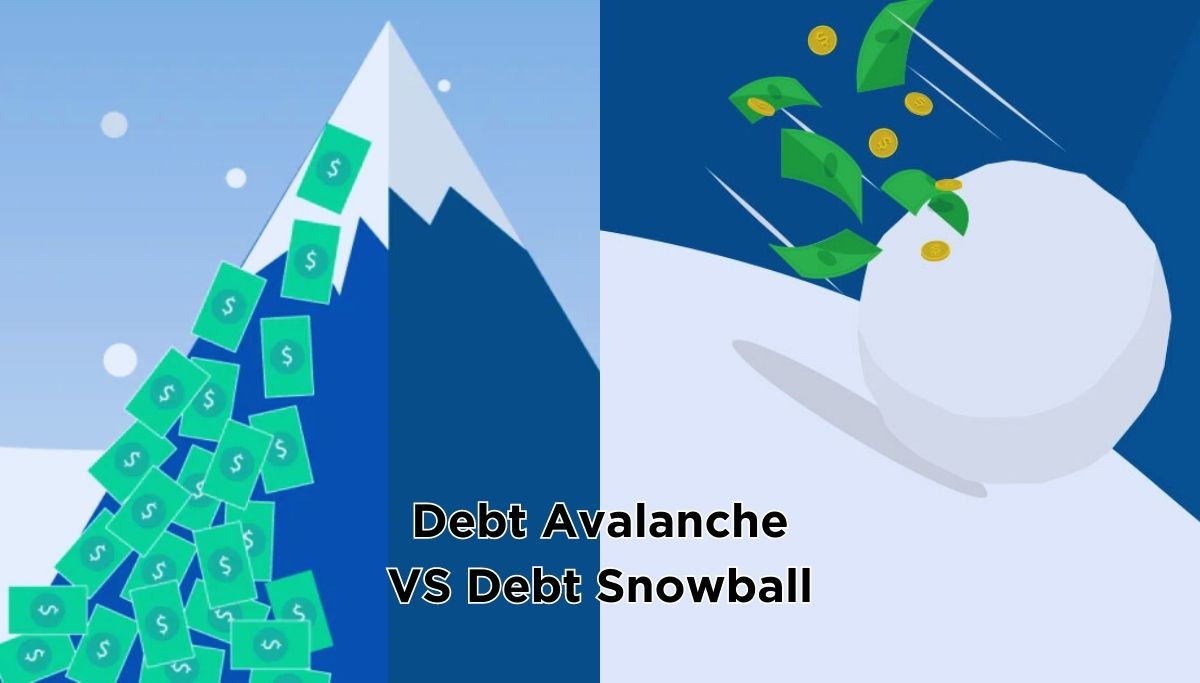The most critical factor when it comes to debt is not how you pay it off, it is really managing to do it. So the right strategy to use is the one you believe you’re going to stick to. The greatest killjoy is debt. It will kill a budget, make it difficult for long-term financial preparation, and shadow any acquisition you make with guilt. With the debt load, no one wants to exist. But how do you bid farewell to the debt you owe? It won’t be quick to climb out from under this wall, so if you’re able to realign your values and do what it takes, no matter how big it is, you will shake off debt. Let’s take a look at two popular approaches for paying down debt, avalanche vs snowball, and discuss the pros and cons of each.

The Method Of The Debt Snowball
Speaking of avalanche vs snowball, investment guru Dave Ramsey popularized the snowball method for staying out of debt. It means concentrating on first paying off the smallest debt and only focusing on the next-smallest debt until all of them are paid off.
Let’s see, using an illustration of how this will work. Assume that you have squeezed an additional $500 out of your income to pay off debt and you have the following debts:
Personal loan of $2,500 at 9.5 percent interest; $50 minimum payment .
A car loan of $10,000 at 3 percent interest; minimum payment of $200.
Credit card debt of $13,000 at 18.99 percent interest; $225 minimum payment.
Student loan of $18,000 at 4.5 percent interest; $300 monthly payment
In this case, except for the smallest, the snowball approach will see you spending only the minimum amount on all debts. You’d put the remaining $500 you had to pay off the personal loan. You’d take the $550 you were paying for the personal loan, and then apply it to the $200 you’re paying for the car loan. You’re paying $750 for your car loan now and you’re able to kick that out after just a year. Keep doing this before you have made all your debts clear.
You’re a step away from a reliable education loan! Fill the form in this blog now!
Pros of the debt snowball method
The most important draw of the system of the debt snowball is that it deals with the adjustment of actions and not with math. Tiny but easy victories are perfect motivators to hold you moving until all the debts have been worked out.
This isn’t just a good theory. Research released by Harvard Business Review showed that beginning a journey with the smallest debt for a debt-free existence helps hold the motivation running before the job is finished.
The Debt Snowball Method’s Cons
Its aversion towards interest rates is the primary downside of the debt snowball process. Second, paying off the tiniest debt will imply hanging onto the debt the longest with the highest interest rate. This involves spending extra, often to the tune of many thousand dollars, in net interest.
The Debt Avalanche Method
The strategy of debt avalanche uses the reverse path to the snowball methodology which recommends first getting rid of the debt with the largest interest rate and then going on to the second-highest. This encourages the debt-payer to shed high-interest rates sooner and to place some of their money on their loans’ principal.
The process of debt avalanche will include first paying off the credit card debt, preceded by the personal loan, student loan, and ultimately the auto loan.
Pros of the debt avalanche method
It can save hundreds, and even thousands, of dollars in interest by paying off the loan with the maximum interest rate. Some people prefer the thought of kicking off their heaviest loans earlier. Ultimately, in most situations, the shorter one would be to take the debt avalanche path from avalanche vs snowball.
Cons of the debt avalanche method
Despite seeing no change, the debt avalanche needs self-motivation to keep the debt-payer plugging away at the plan. When the figures are not moving, it’s harder to feel like you’re going there, but with those who are genuinely inspired who think they can stick to the strategy until they see success, it can help.

Avalanche vs Snowball
You pay off the debt in an attempt to pay the smallest amount to the highest, regardless of interest cost, with the debt snowball process. For anything except the smallest loan, you make minimal contributions and hit the one with a vengeance. You switch to the next smallest one and loop before you plow through all the debt until the bill is settled.
The benefit of the debt snowball is that once you’re debt-free, it encourages you to remain intent on paying one payment at a time. You are granted control over your loans through this means of paying off your bills. You’ll see that you are in control of your money as you clear the first bill and pass it on to the next. And how inspiring is that!
There is a common aim for the debt snowball vs avalanche: to make you debt-free. Yet inspiration is given by the debt snowball, and motivation is the magic sauce that makes you debt-free quicker. You get a glimpse of victory as you pay off the smallest loan first. And that sense of accomplishment is the momentum with a vengeance that you need to face the next debt.
You can not get a sense of satisfaction for a long time with the debt avalanche. Long before you even pay off the first loan, you might lose momentum and give up. Yeah, beginning with the debt that has the highest interest rate could make sense mathematically, but if we were concentrated on arithmetic, there is a chance that we might not be in debt in the first place.
Which Is The Best Approach For You?
Factors such as your attitude and lifestyle play a part in deciding which avalanche vs snowball method is the right option for you. You can try a snowball vs avalanche calculator for understanding the best approach. You may want to use the debt snowball approach if you felt you’d like early motivation to keep working. Is seeking an approach that can cost you less time and resources your chief concern? You would want to go for the avalanche approach in that scenario.
You may want to run your calculations into a debt-paying calculator before you make your choice from avalanche vs snowball to see how much interest you’d spend using each option and how long each solution would take.
There is no justification to believe that if you make your decision, you’ll be stuck with one form. As per the debt avalanche strategy, you can still turn approaches from avalanche vs snowball down the road, or determine early to get rid of the debt with the maximum interest rate first, and only work towards paying off the remainder in sequence from smallest to biggest, according to the debt snowball technique.
If the thing that really motivates you is to see your debt shrink as fast as possible, then debt avalanche is a better option for you. For left-brained, numbers-based persons, that’s the perfect option because it saves you more money in interest rates and takes you out of debt more easily.
On the other side, debt snowball will be a strong choice for you if you get a major morale boost by watching a debt disappear entirely. For emotional individuals who require short-term wins to hold them motivated, this approach fits well. You may use debt snowflaking to chip away at your debt ever further, reducing your repayment period, no matter which tool you select.
To get the advantages of either one, it’s even necessary to merge the two processes. If you have many minor loans, before going on to the others, you can first fix the highest-interest one. You also get a fast reward because it’s a minor debt and you still get the savings that come from paying off high-interest debt.
Another nice part about the debt snowball vs avalanche is that even though all the loans are finished, they can keep working for you. You can easily take the monthly amount you have expended on debt payments until you pay off the last debt and instead start investing money into low-risk savings. That way, you will watch your nest egg expand instead of seeing your debt shrink every month, an even more satisfying experience of investment as a student.










0 Comments